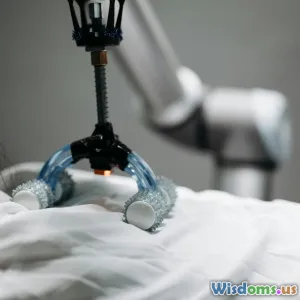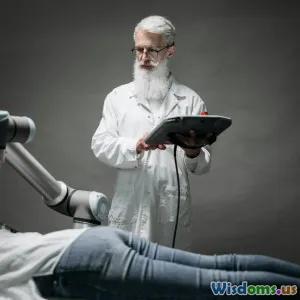
The Role of AI in Medical Robotics
7 min read Explore how AI revolutionizes medical robotics, enhancing precision, diagnostics, and patient care with cutting-edge technology. (0 Reviews)
The Role of AI in Medical Robotics: Revolutionizing Healthcare
Introduction
Imagine a world where surgeries are executed with unparalleled precision, complex diagnoses become faster and more accurate, and robotic systems assist doctors in delivering personalized care like never before. This compelling vision is no mere futuristic fantasy; it’s rapidly becoming reality thanks to the seamless integration of Artificial Intelligence (AI) into medical robotics. AI-powered medical robots are not just tools but transformative partners in healthcare, reshaping the boundaries of what is medically possible.
This article explores the critical role AI plays in medical robotics — from assisting in minimally invasive surgeries to optimizing post-operative care — highlighting how this fusion of technologies is revolutionizing medicine.
Understanding Medical Robotics and AI
Medical robotics involves robotic systems designed to assist or automate tasks within clinical settings. Such systems range from surgical robots and rehabilitation aids to diagnostic machines. Artificial Intelligence, particularly machine learning, natural language processing, and computer vision, endow these robots with the ability to learn, reason, and respond dynamically.
By integrating AI, medical robots transition from pre-programmed machines to intelligent systems capable of enhancing decision-making, adapting to patient-specific needs, and performing complex tasks autonomously.
AI-Driven Precision in Surgical Robotics
Enhancing Minimally Invasive Surgery
Surgical robots like the da Vinci Surgical System have transformed operative procedures through greater dexterity and precision. Their AI components analyze live data and provide real-time feedback, enabling surgeons to operate with enhanced accuracy. For example, AI algorithms can optimize instrument movement paths, minimizing damage to healthy tissues.
Real-time Imaging and Surgical Navigation
AI-powered computer vision integrated into robots allows the real-time identification of anatomical structures during procedures. This imaging guidance increases the safety and success rate of complex surgeries, such as neurosurgery and cardiac interventions. Research published by the IEEE Transactions on Medical Robotics reveals a 20% decrease in operative errors when AI-assisted navigation is applied.
Learning from Every Surgery
AI systems can learn from thousands of surgical cases, identifying patterns linked to better outcomes. These insights help to personalize surgical approaches based on patient variables. By learning continuously, surgical robots evolve into increasingly skilled assistants over time.
Revolutionizing Diagnosis and Patient Monitoring
AI Diagnostics Complementing Robotic Precision
Robotic medical systems equipped with AI analyze medical images like MRIs, CT scans, and X-rays with remarkable speed and accuracy. For instance, IBM Watson Health leverages AI to assist radiologists by flagging abnormalities that might be missed by the human eye, increasing disease detection rates.
Robotics in Telemedicine and Remote Monitoring
AI-powered robots facilitate remote patient monitoring through wearable sensors and automated data collection. For chronic disease management, such systems provide continuous health tracking and timely alerts to caregivers. This capability was crucially demonstrated during the COVID-19 pandemic, reducing healthcare worker exposure while ensuring patient care continuity.
AI and Robotic Rehabilitation
Rehabilitation robotics harness AI to deliver tailored therapy, adjusting difficulty based on patient progress. Examples include exoskeleton suits, which use AI to interpret movement intentions, promoting motor recovery in stroke survivors. A 2021 study from Frontiers in Neurology reported that patients using AI-enhanced robotic rehabilitation devices improved limb function by 30% faster compared to conventional therapy.
Overcoming Challenges in AI-Enabled Medical Robotics
Data Privacy and Ethical Concerns
Integrating AI necessitates accumulating vast amounts of sensitive patient data, raising privacy and security concerns. Healthcare providers must navigate robust regulations like HIPAA to safeguard information while advancing technology.
Ensuring Reliability and Safety
Medical robotics must meet the highest standards of reliability given the stakes involved. AI systems face challenges such as biases in training data and the unpredictability of real-world scenarios. Continuous testing, validation, and regulatory oversight remain critical.
Future Outlook: AI as a Catalyst for Transformative Healthcare
Looking ahead, AI will enable even greater autonomy for medical robots, including fully automated surgeries and predictive diagnostics based on genetic and lifestyle data. The rise of explainable AI will assure clinicians that autonomous decisions by robots are transparent and trustable.
Investments by tech giants and startups alike underscore this momentum — Google's DeepMind and Intuitive Surgical, among others, are pioneering next-generation AI-robot collaborations that could democratize access to high-quality healthcare worldwide.
Conclusion
The marriage of AI and medical robotics heralds a revolutionary era where complex medical tasks once bound by human limitations can be enhanced and automated effectively. This synergy not only elevates diagnostic accuracy and surgical precision but also personalizes patient care on an unprecedented scale.
As challenges around ethics, safety, and data privacy are addressed, AI-driven medical robotics promise to redefine the standard of care — empowering healthcare providers and improving lives globally. Embracing this technology today paves the way for a smarter, safer, and more efficient healthcare landscape tomorrow.
References:
- IEEE Transactions on Medical Robotics, 2020
- Frontiers in Neurology, Rehabilitation Robotics Study, 2021
- IBM Watson Health Publications
- Intuitive Surgical, Company Reports
- HIPAA Regulatory Guidelines
Author’s note: Continued research and clinical trials will further illuminate AI's capabilities in medical robotics. Healthcare professionals and technologists must collaborate to harness this technology responsibly.
Rate the Post
User Reviews
Popular Posts



















